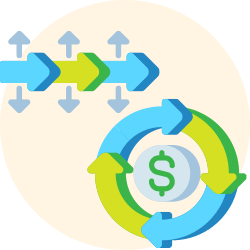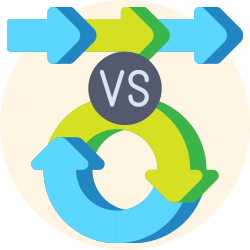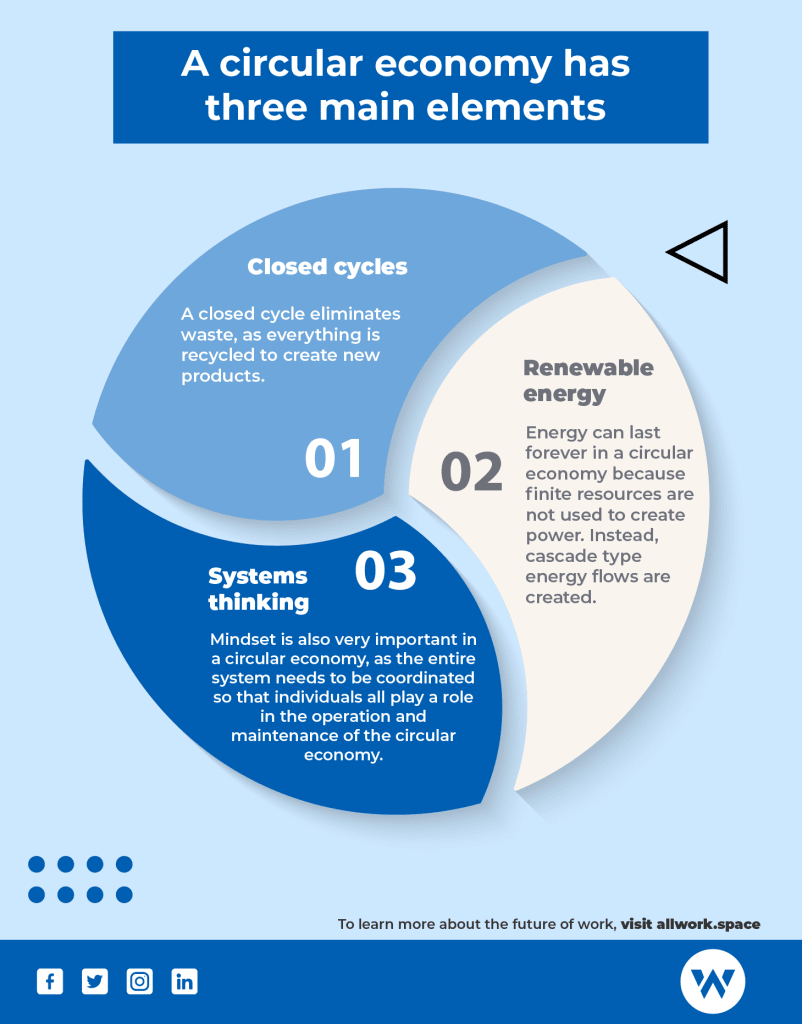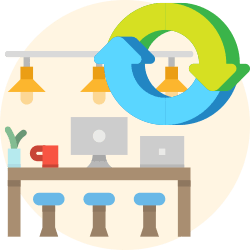Studies show the linear economy is completely unsustainable. Allwork.Space shares how the circular economy is less wasteful in a post-COVID world.

This article was originally published by Allwork.Space.
The circular economy is becoming an increasingly popular concept around the world. But what does it mean? How does it differ from our “traditional” linear economy? How will it impact our world as we recover from the pandemic?
What is a linear economy? What is a circular economy?

A linear model deals with raw materials in an inefficient way, because the emphasis is not on their conservation. Materials are collected, then transformed into products, which are eventually discarded as waste.
What experts and non-experts know for sure is that if this economic model is not replaced, the world will approach a tipping point where it will lose the capacity to sustain itself.
A circular economy follows the reduce, reuse and recycle approach. Resource use is minimized, reuse of products and parts is maximized, and raw materials are reused to a high standard. When working on sustainability within a linear economy, the focus is on eco-efficiency, which means the ecological impact is minimized to get the same output.
The circular economy is repurposing empty office spaces

The shift to remote working has caused many offices to become empty, some of which are being converted into living spaces.
Many office buildings have been vacant for more than a year and a half now as the pandemic continues to keep workers out of cities.
High office vacancy rates are plaguing cities nationwide, In the second quarter of this year, the commercial vacancy rate across San Francisco reached 15.4% – more than the 12% figure last year and more than double what it was just two years ago.
Phoenix’s office market vacancy is elevated at 16.2%, while Los Angeles has reached an all-time high of 17.8%.
Meanwhile, New York City is at 19.2% vacancy, and Houston is at a record high 22.9% of workspaces going unused.
Some of those properties may never recover, but many empty commercial structures are planned to be converted into housing and perhaps other uses as well, potentially spurring a number of building conversions not seen since the crash of the late-1980s.
New York City has provided tax breaks for converting unused commercial buildings into residential space since the 1990s. In the 2010s, the most common spaces to be retrofitted into rentals have been office buildings.
With some companies allowing employees to permanently work from home, there is support across cities for breathing new life into struggling buildings.
“COVID has expedited the ultimate repurposing,” said Nathan Berman, managing principal of Metroloft Management and a developer in the process of buying two large office buildings in lower Manhattan.
In other countries, the same sentiment is being felt.
South Korea plans to add 114,000 homes for public housing by buying empty hotels and offices.
Eight out of 10 workers in Singapore prefer to work from home or have flexible arrangements, according to a survey in October, which would leave plenty of vacant offices and car parks to be converted.
Justin Eng, an associate director of research at real estate consultancy Knight Frank Asia-Pacific, said, “Governments and developers across the region are looking at converting commercial space into housing. These trends had been in motion prior to COVID-19, but have now been accelerated.”
Retrofitting, refurbishing or repairing existing buildings will lead to lower emission facilities, which is less resource-intensive and more cost-effective than demolition and new construction. This model fits in with the circular economy, which could help the world recover financially from the pandemic.
In San Francisco, one empty office building has even been converted into a school. Not only is this environmentally conscious, but it allows upcoming schools to have space without building from scratch.
Using now-obsolete office spaces for another function (like a school) eliminates the need to use raw materials to build a new building. Retrofitting an empty space aligns with the principles of the circular economy: maintaining products so that they remain useful.
What is the difference between a circular and linear economy?

A circular economy is fundamentally different from a linear economy in that a linear economy follows the “take-make-dispose” plan, which means that raw materials are collected, then transformed into products that are used until they are finally discarded as waste. Value is created in this economic system by producing and selling as many products as possible.
In a circular economy, the cycle of mining raw materials is closed, which changes the way in which value is created and preserved, how production is made more sustainable and which business models are used.
Circular thinking is focused on the general well-being of the populace instead of focusing on boosting the competitiveness, profitability or growth of businesses and economies.
While some might say that the linear economy is more profitable compared to the circular economy, experts say that this is not the case. In fact, the circular economy’s prioritization of recycling waste can lead to higher profits, increased competitiveness, more jobs for workers, and more long-term sustainability of businesses.

A circular economy has three main elements:
- Closed cycles: A closed cycle eliminates waste, as everything is recycled to create new products.
- Renewable energy: Energy can last forever in a circular economy because finite resources are not used to create power. Instead, cascade type energy flows are created.
- Systems thinking: Mindset is also very important in a circular economy, as the entire system needs to be coordinated so that individuals all play a role in the operation and maintenance of the circular economy.
Issues with the linear economy
- Studies have shown that this economic model is completely unsustainable. The only exception is if significant recycling programs are put into place.
- For nations that adhere to a linear economy, the environment is viewed as a simple, free resource with no limitations.
- The volume of products produced in this system is typically very high.
The negative aspects of this economic model are clear to see. It can create financial instability, social inequality, misuse of or lack of use of building/property, waste dumped on the land and in the oceans, and environmental destruction.
Linear economy advantages
- The linear economy allows as many products as possible to be created and sold.
- It allows nations to exploit natural resources to their fullest extent.
While these do not seem so much like advantages to the average person, these are advantages to businesses and manufacturers.
What are the implications for a circular economy in a post-COVID world?

The value of a circular economy could reach $4.5 trillion by 2030. This is between 4-5% of the projected global gross domestic product.
But a joint effort is required to make the circular economy work; people from many different industries need to cooperate to make it happen – which includes the lowest worker to the highest CEO.
The linear economy must first transition to a “reuse economy” before making the final switch to a circular economy.
While a reuse economy still produces waste, it prioritizes recycling, which is a necessary stepping stone to achieve a circular economy.
The world can leverage the positive and negative effects of the pandemic to begin to build a new, more resilient and low-carbon economy.
“The pandemic has highlighted the environmental folly of ‘extract, produce, use and dump’ economic model of material and energy flows, however the short-term resolutions to cope with the pandemic will not be sustainable in the long-run, as they do not reflect improvements in economic structures of the global economy,” Dr. Taofeeq Ibn-Mohammed, University of Warwick said.
If we want to begin to create sustainable societies, we must first repurpose and reuse existing resources. Instead of building new properties – businesses, developers and companies should repurpose existing buildings.
The pandemic has left many office buildings mostly empty due to the popularization of remote working; these spaces can be converted into housing, which would be helpful during the current housing crisis.
The world is changing rapidly with flex space

The end of office real estate is only one sign of a rapidly-changing economy with shifting priorities.
The pandemic has shown us all that working from home is the new normal and that many companies don’t actually need massive office buildings. The death of office real estate and the shift towards flex spaces is just one example of how this transition is taking place.
When businesses need to host meetings or engage in team-building exercises, they can simply book a flex space, which are office spaces that can be booked on an as-needed basis. This eliminates higher rental costs for businesses (especially startups), and it can reduce the number of empty office buildings. Similarly, many self-employed workers utilize coworking spaces because working from home every day has its downsides; the negative impacts have been well-documented.
When workers are geographically dispersed, they have a lower impact on communities, the environment, and the global economy.
Many other industries should participate in this movement towards a circular economy; there is much more work to be done before we can truly protect our resources, recycle our products, and reuse whenever possible.



Thank you for sharing this information on the differences between a linear and circular economy. This was very interesting to learn about.